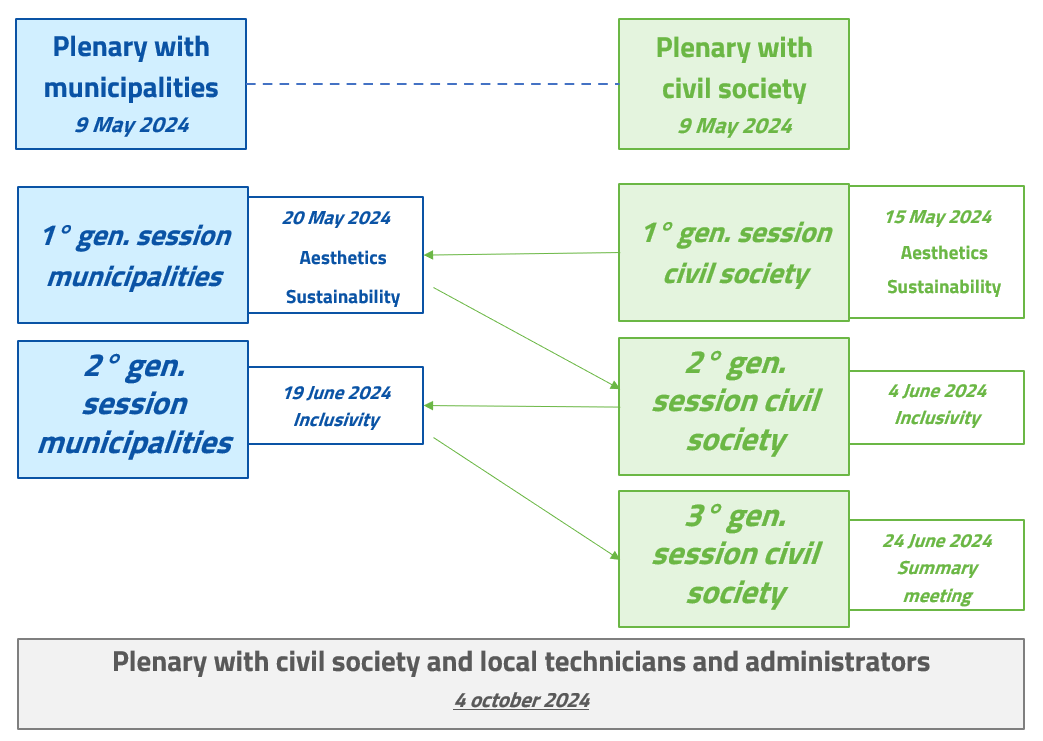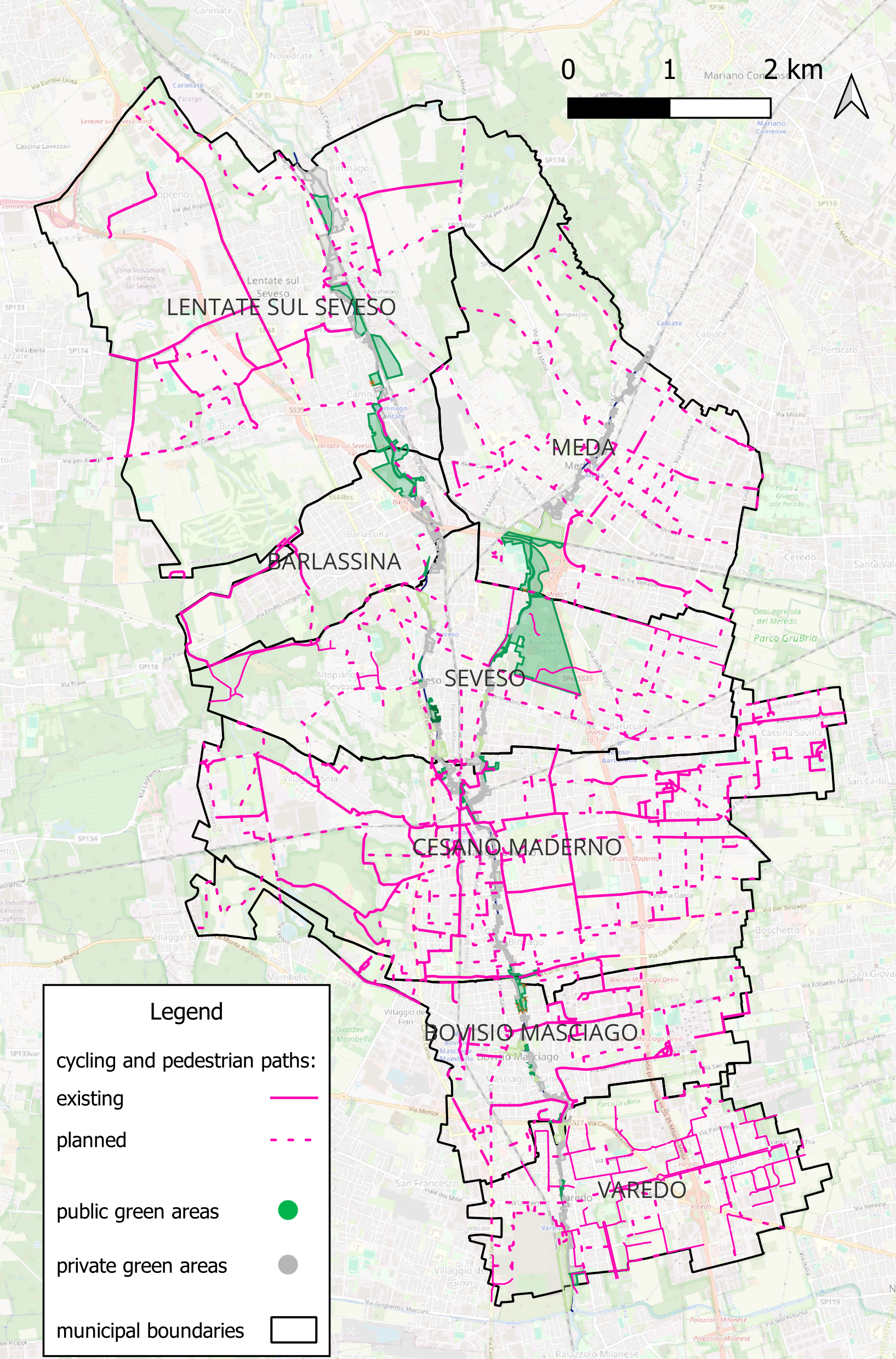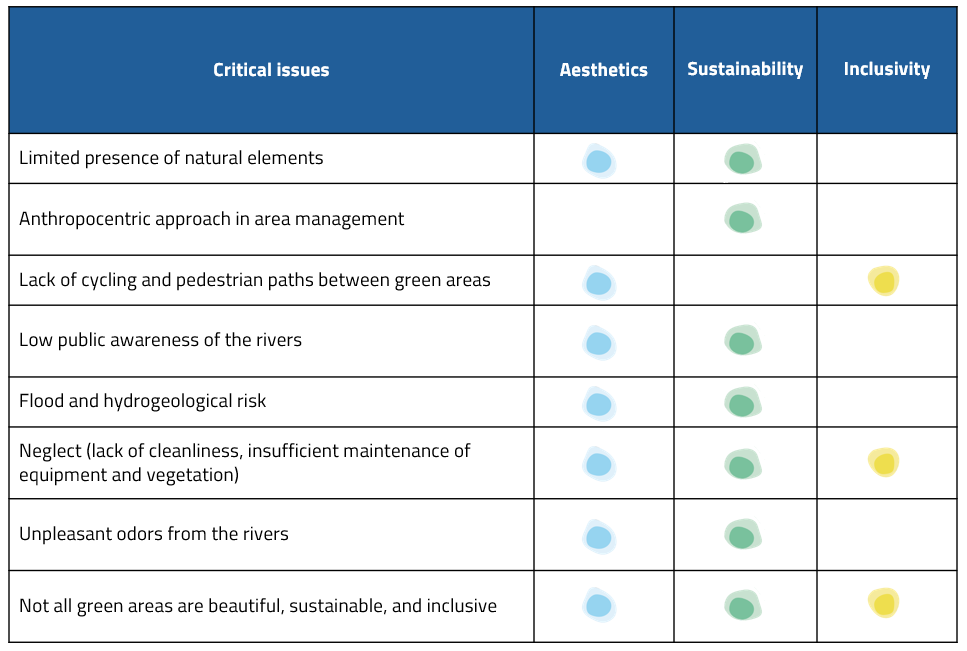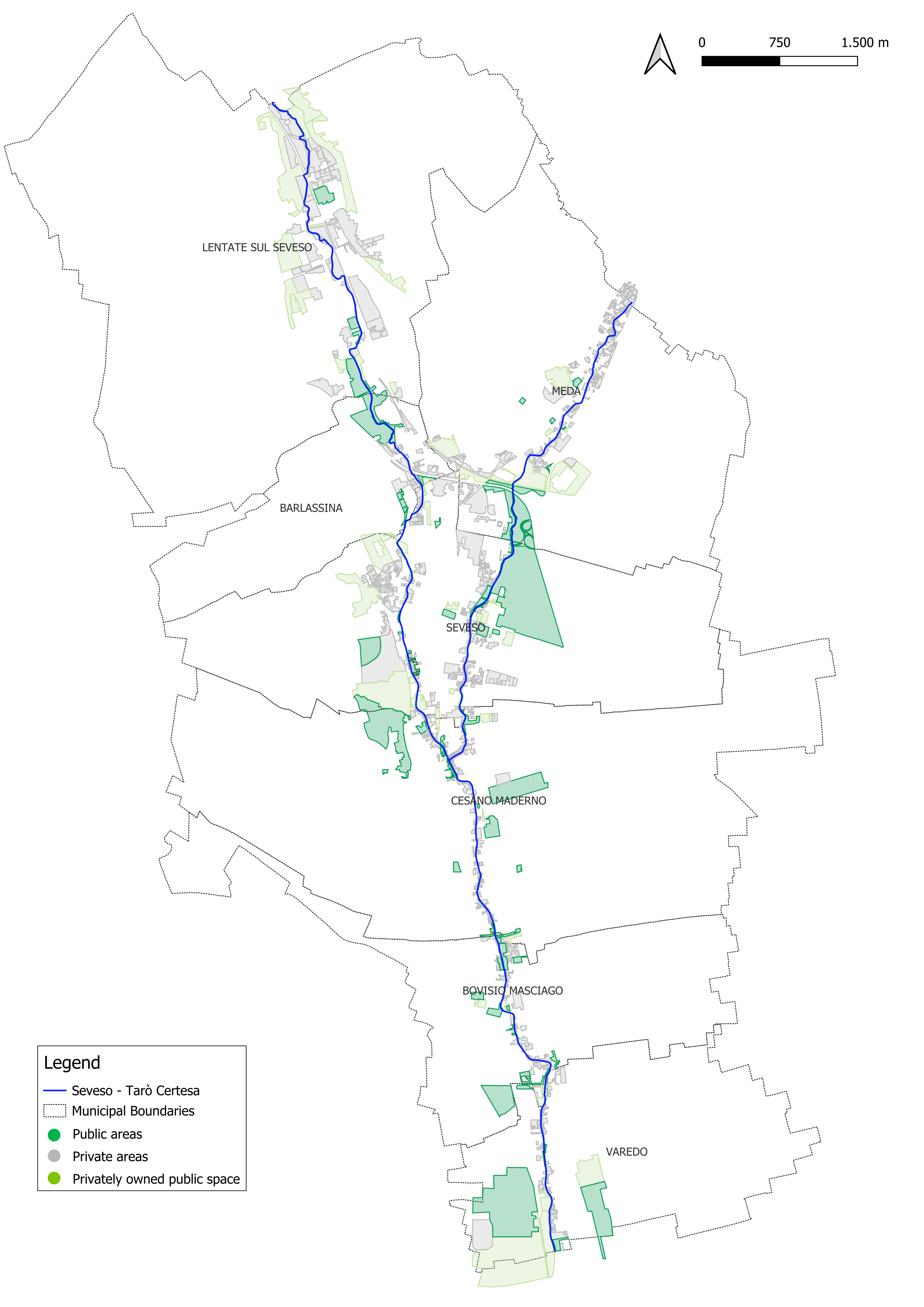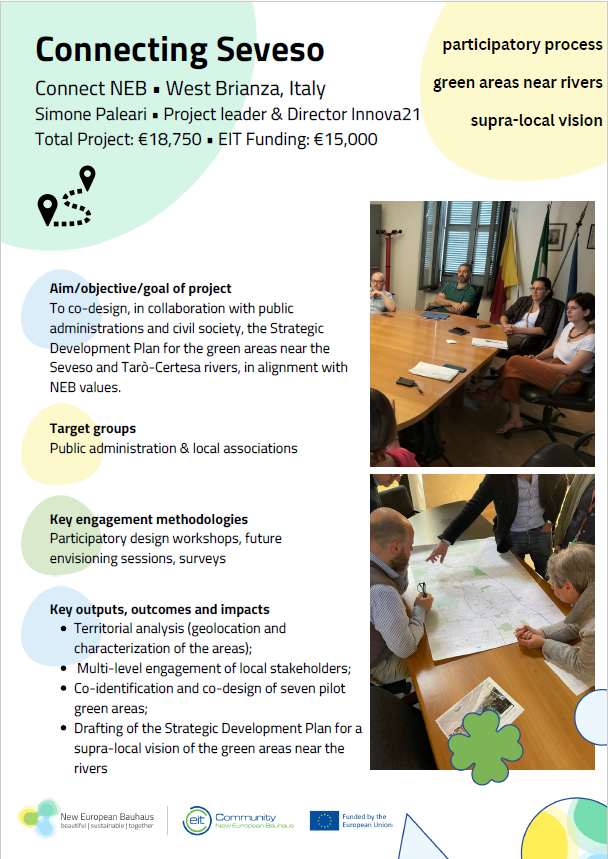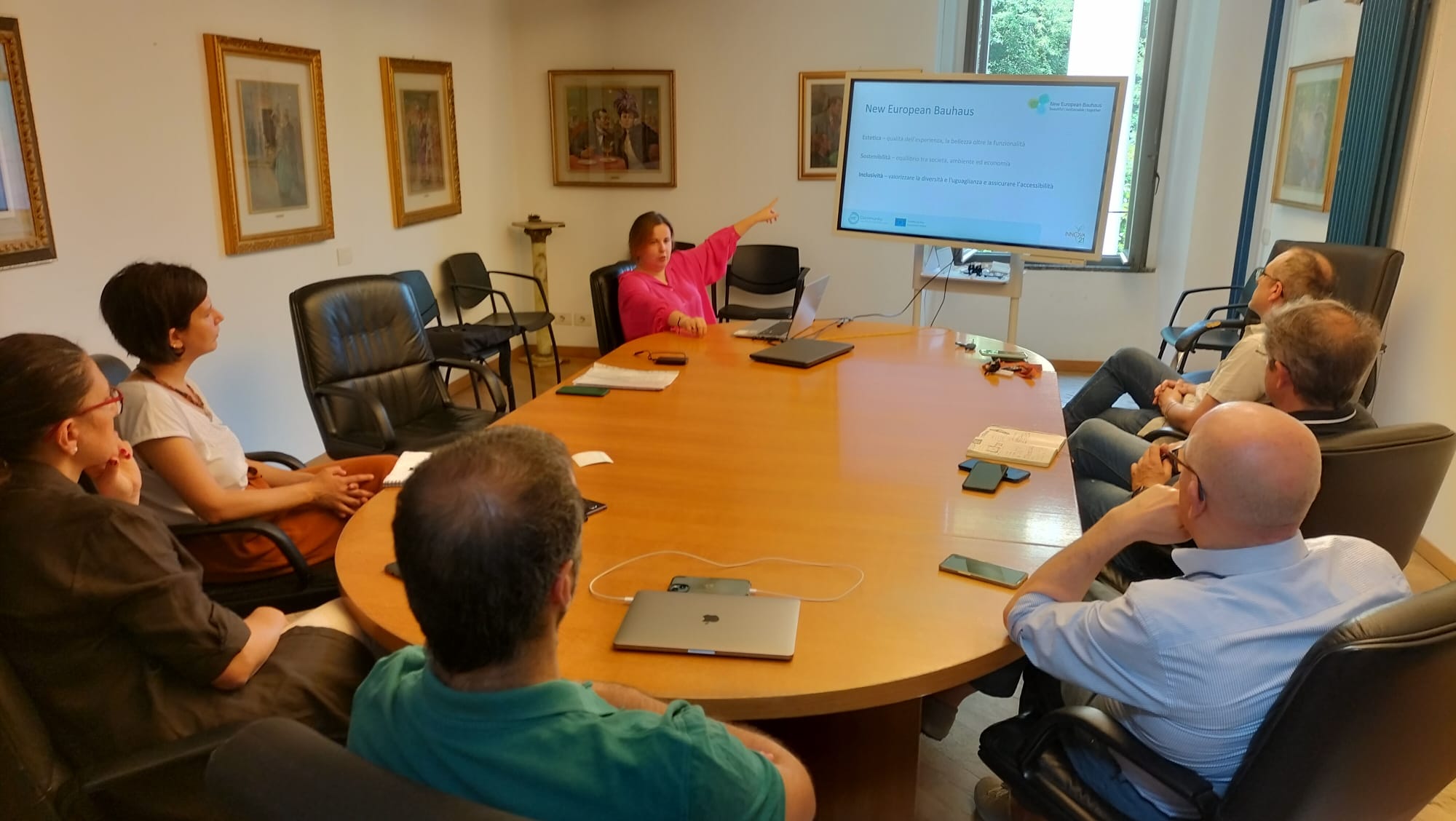Reconnecting with nature
Connecting Seveso
Connecting Seveso
Connecting Seveso brings together public administrations and civil society to shape the future of green areas along the Seveso and Tarò-Certesa rivers. Through participatory workshops, future envisioning, and surveys, we co-design seven pilot areas and craft a Strategic Development Plan aligned with NEB values. Our goal: a shared, sustainable, and thriving vision for these vital landscapes!
Italy
Local
7 municipalities in West Brianza: Varedo, Bovisio Masciago, Cesano Maderno, Seveso, Barlassina, Lentate sul Seveso, Barlassina
Mainly urban
It refers to other types of transformations (soft investment)
Yes
2024-11-30
Yes
EIT Community Connect NEB: Citizen-generated solutions and initiatives to advance sustainability, beauty and inclusivity – 2024
No
No
As a representative of an organisation
Connecting Seveso is a participatory initiative that brings together public administrations and civil society to co-design a Strategic Development Plan for the green areas along the Seveso and Tarò-Certesa rivers, in alignment with New European Bauhaus (NEB) values of sustainability, inclusivity, and aesthetics. Targeting public administrations and local cultural and environmental associations, the project fosters a collaborative and inclusive process based on universal design principles, aiming to restore and enhance ecological connectivity in a highly urbanized area through the renaturalization of degraded spaces. By promoting the role of urban greenery in climate change adaptation, it encourages municipalities to adopt multi-functional solutions that integrate environmental, social, and mobility needs while improving accessibility through the expansion of cycle paths and better connectivity to the Seveso River, fostering a stronger relationship between local communities and their natural surroundings. The project has played a crucial role in stimulating debate on flood risk management and the redevelopment of green spaces along the Seveso River, reinforcing the need for coordinated interventions. As a result, a Strategic Development Plan has been developed and formally approved by the seven municipal councils involved. This process was supported by on-site assessments in seven pilot green areas, where participatory co-design sessions defined concrete regeneration strategies. These seven areas have been officially included in the Seveso River Contract Action Program, a key instrument of the Lombardy Region that facilitates access to funding opportunities for future implementation. Furthermore, the project has contributed to launching discussions on the "Seveso River Park", leading to the Lombardy Region's official decision to initiate working groups for its establishment, ensuring greater protection for the green areas surrounding the river and its tributaries.
participatory process
green areas near rivers
supra-local vision
co-design
multi-level engagement
The key objectives of the project in terms of sustainability have been met through the following actions:
1. Participatory Meetings: Throughout the participatory process, the focus was placed on the sustainability of the green areas. These meetings allowed stakeholders, including local communities, environmental associations, and public administrations, to discuss and prioritize sustainable practices for the management and development of the areas along the Seveso and Tarò-Certesa rivers.
2. Co-Design Workshops: In these workshops, the focus was on how to make the green areas along the rivers more sustainable compared to their current state. Discussions included practical solutions for improving ecological connectivity, enhancing biodiversity, and promoting the use of nature-based solutions to address climate change, such as flood risk management and green space restoration.
3. Strategic Development Plan: The Strategic Development Plan was created to consolidate the findings and outcomes from the co-design workshops, with a particular focus on environmental sustainability. This document outlines concrete actions to improve the ecological health and sustainability of the green areas, ensuring that the proposed solutions are aligned with climate adaptation goals and long-term environmental protection.
These efforts make the project exemplary by directly addressing sustainability in urban green spaces through collaborative, inclusive processes and the creation of a comprehensive, actionable plan that can guide future development and investment in these areas.
1. Participatory Meetings: Throughout the participatory process, the focus was placed on the sustainability of the green areas. These meetings allowed stakeholders, including local communities, environmental associations, and public administrations, to discuss and prioritize sustainable practices for the management and development of the areas along the Seveso and Tarò-Certesa rivers.
2. Co-Design Workshops: In these workshops, the focus was on how to make the green areas along the rivers more sustainable compared to their current state. Discussions included practical solutions for improving ecological connectivity, enhancing biodiversity, and promoting the use of nature-based solutions to address climate change, such as flood risk management and green space restoration.
3. Strategic Development Plan: The Strategic Development Plan was created to consolidate the findings and outcomes from the co-design workshops, with a particular focus on environmental sustainability. This document outlines concrete actions to improve the ecological health and sustainability of the green areas, ensuring that the proposed solutions are aligned with climate adaptation goals and long-term environmental protection.
These efforts make the project exemplary by directly addressing sustainability in urban green spaces through collaborative, inclusive processes and the creation of a comprehensive, actionable plan that can guide future development and investment in these areas.
The key objectives of the project in terms of aesthetics and quality of experience for people have been addressed and met through various initiatives, ensuring the project is not only environmentally sustainable but also provides a positive and engaging experience for participants and future visitors.
1.Participatory Meetings: The theme of aesthetics and the quality of the experience was a central focus during the participatory process. The meetings were designed to ensure that all participants had an enjoyable and welcoming experience. Locations for the meetings were carefully selected to be accessible and comfortable for all, with consideration for the local community's needs. Additionally, the events featured welcoming buffets and a warm, inviting atmosphere to create a positive and inclusive environment. This approach encouraged a diverse range of individuals to participate and share their perspectives, ensuring that their views on the aesthetic and experiential aspects of the green areas were heard.
2.Co-Design Workshops: In these workshops, the focus was on how to improve the aesthetic quality of the green areas while also enhancing the overall experience for visitors. Participants co-designed public spaces that were visually appealing, accessible, and functional. Ideas were discussed to incorporate art, landscaping, and natural elements that would not only beautify the areas but also create environments that encourage people to connect with nature. The design process emphasized creating spaces that foster relaxation, recreation, and community interaction, promoting a strong sense of place and identity.
3.Strategic Development Plan: The Strategic Development Plan reflects the outcomes of the participatory workshops, addressing the aesthetic qualities and user experience of the green areas. It includes detailed recommendations on how to improve the public spaces, integrating elements like art installations, improved pathways, seating areas, and landscaping t
1.Participatory Meetings: The theme of aesthetics and the quality of the experience was a central focus during the participatory process. The meetings were designed to ensure that all participants had an enjoyable and welcoming experience. Locations for the meetings were carefully selected to be accessible and comfortable for all, with consideration for the local community's needs. Additionally, the events featured welcoming buffets and a warm, inviting atmosphere to create a positive and inclusive environment. This approach encouraged a diverse range of individuals to participate and share their perspectives, ensuring that their views on the aesthetic and experiential aspects of the green areas were heard.
2.Co-Design Workshops: In these workshops, the focus was on how to improve the aesthetic quality of the green areas while also enhancing the overall experience for visitors. Participants co-designed public spaces that were visually appealing, accessible, and functional. Ideas were discussed to incorporate art, landscaping, and natural elements that would not only beautify the areas but also create environments that encourage people to connect with nature. The design process emphasized creating spaces that foster relaxation, recreation, and community interaction, promoting a strong sense of place and identity.
3.Strategic Development Plan: The Strategic Development Plan reflects the outcomes of the participatory workshops, addressing the aesthetic qualities and user experience of the green areas. It includes detailed recommendations on how to improve the public spaces, integrating elements like art installations, improved pathways, seating areas, and landscaping t
The key objectives of the project in terms of inclusion have been met by focusing on accessibility, usability, and reachability, ensuring that all members of the community, regardless of their background or abilities, could participate and benefit from the process. The project's approach to inclusivity was reflected in every stage, from participatory meetings to co-design workshops and the development of the Strategic Development Plan.
1.Participatory Meetings: Inclusivity was a key principle during the participatory meetings. Locations were chosen based on their accessibility, ensuring that they were easy to reach by public transport and wheelchair-friendly. Furthermore, at the end of each meeting, we conducted a survey to gather feedback and assess the inclusivity of the events. This feedback loop allowed us to improve the experience for future participants, ensuring the meetings remained welcoming and inclusive. The average rating from participants was 4.4/5, indicating a high level of satisfaction with the inclusivity of the process.
2.Co-Design Workshops: In the co-design workshops, the focus was on designing spaces that were accessible and usable by all, including people with disabilities, children, and the elderly. The design process integrated universal design principles, ensuring that the green areas were not only beautiful and sustainable but also accessible and functional for people with diverse needs. This approach aimed to create spaces where all community members, regardless of their abilities, could interact, relax, and engage with the environment.
3.Strategic Development Plan: The Strategic Development Plan incorporates the principles of accessibility and inclusion by outlining actions to improve the connectivity and reach of green areas, ensuring that they are accessible to people from different neighborhoods, with a focus on eliminating physical and social barriers. The plan also promotes the creation of inclusive public spaces that can be enjoy
1.Participatory Meetings: Inclusivity was a key principle during the participatory meetings. Locations were chosen based on their accessibility, ensuring that they were easy to reach by public transport and wheelchair-friendly. Furthermore, at the end of each meeting, we conducted a survey to gather feedback and assess the inclusivity of the events. This feedback loop allowed us to improve the experience for future participants, ensuring the meetings remained welcoming and inclusive. The average rating from participants was 4.4/5, indicating a high level of satisfaction with the inclusivity of the process.
2.Co-Design Workshops: In the co-design workshops, the focus was on designing spaces that were accessible and usable by all, including people with disabilities, children, and the elderly. The design process integrated universal design principles, ensuring that the green areas were not only beautiful and sustainable but also accessible and functional for people with diverse needs. This approach aimed to create spaces where all community members, regardless of their abilities, could interact, relax, and engage with the environment.
3.Strategic Development Plan: The Strategic Development Plan incorporates the principles of accessibility and inclusion by outlining actions to improve the connectivity and reach of green areas, ensuring that they are accessible to people from different neighborhoods, with a focus on eliminating physical and social barriers. The plan also promotes the creation of inclusive public spaces that can be enjoy
The involvement of citizens and civil society in the project has been crucial to ensuring that the outcomes are aligned with community needs and aspirations. Their participation has had a direct impact on the design and development of green spaces, as well as in fostering a sense of ownership and responsibility towards the environment.
1.Participation in Participatory Design Workshops, Future Envisioning Sessions, and Surveys: Citizens were actively involved in a series of participatory design workshops, future envisioning sessions, and surveys. These activities enabled participants to express their ideas and concerns about the future of the green areas along the Seveso and Tarò-Certesa rivers. Through these platforms, citizens contributed their local knowledge and preferences, shaping the vision for the green spaces.
2.Co-Identification and Co-Design of Seven Pilot Green Areas: Citizens played a pivotal role in the co-identification and co-design of seven pilot green areas. Together with local authorities and experts, they helped define the objectives and features of these areas, ensuring that the design was in line with New European Bauhaus (NEB) values such as sustainability, accessibility, and beauty. This collaborative effort ensured the spaces would meet both ecological and social needs.
3.Co-Design of the Strategic Development Plan: Citizens contributed directly to the co-design of the Strategic Development Plan, providing feedback and suggestions that influenced the final document. Their insights were incorporated to guarantee that the plan would reflect the community’s priorities and enhance the long-term sustainability and usability of the green spaces.
4.Initiation of Working Groups for the Seveso River Park: The project also played a key role in kickstarting discussions about the creation of the Seveso River Park. Citizens' involvement in these initial working groups has helped to build momentum for the establishment of the park, ensuring that their
1.Participation in Participatory Design Workshops, Future Envisioning Sessions, and Surveys: Citizens were actively involved in a series of participatory design workshops, future envisioning sessions, and surveys. These activities enabled participants to express their ideas and concerns about the future of the green areas along the Seveso and Tarò-Certesa rivers. Through these platforms, citizens contributed their local knowledge and preferences, shaping the vision for the green spaces.
2.Co-Identification and Co-Design of Seven Pilot Green Areas: Citizens played a pivotal role in the co-identification and co-design of seven pilot green areas. Together with local authorities and experts, they helped define the objectives and features of these areas, ensuring that the design was in line with New European Bauhaus (NEB) values such as sustainability, accessibility, and beauty. This collaborative effort ensured the spaces would meet both ecological and social needs.
3.Co-Design of the Strategic Development Plan: Citizens contributed directly to the co-design of the Strategic Development Plan, providing feedback and suggestions that influenced the final document. Their insights were incorporated to guarantee that the plan would reflect the community’s priorities and enhance the long-term sustainability and usability of the green spaces.
4.Initiation of Working Groups for the Seveso River Park: The project also played a key role in kickstarting discussions about the creation of the Seveso River Park. Citizens' involvement in these initial working groups has helped to build momentum for the establishment of the park, ensuring that their
The project aimed to engage stakeholders at the local, regional, national, and European levels, ensuring a comprehensive approach to design and implementation.
At the local level, the project primarily involved local administrators, municipal technicians, and territorial associations. The municipal technicians played a key role in facilitating the territorial analysis, sharing their databases and contributing significantly to the participatory process. They worked closely with local associations to co-design the Strategic Development Plan, ensuring the plan reflected local needs and priorities. Additionally, the local administrators officially adopted the Strategic Development Plan through formal approval by the municipal council, making the document a key reference for future development.
Thanks to the project’s scalability, regional stakeholders, including regional administrators and technicians, were also engaged. Lombardy Region decree invited regional technicians (involved in Seveso River Contracts) to launch working groups for the creation of the Seveso River Park, which encompasses a larger territorial scale than the project. This broader involvement ensures that the outcomes of the project are integrated into regional planning and contribute to the creation of a larger, long-term green infrastructure.
At the national and European levels, the project aligned with New European Bauhaus (NEB) values, promoting sustainability, inclusivity, and aesthetic value. The engagement of these wider stakeholders provided the project with access to broader frameworks, aligning local actions with regional and national strategies, and contributing to the European vision of sustainable urban and environmental development.
In summary, the engagement of stakeholders at various levels added immense value by creating a multi-tiered collaboration, ensuring the project was not only rooted in local needs but also connected to regional and national initiatives, setting the foundat
At the local level, the project primarily involved local administrators, municipal technicians, and territorial associations. The municipal technicians played a key role in facilitating the territorial analysis, sharing their databases and contributing significantly to the participatory process. They worked closely with local associations to co-design the Strategic Development Plan, ensuring the plan reflected local needs and priorities. Additionally, the local administrators officially adopted the Strategic Development Plan through formal approval by the municipal council, making the document a key reference for future development.
Thanks to the project’s scalability, regional stakeholders, including regional administrators and technicians, were also engaged. Lombardy Region decree invited regional technicians (involved in Seveso River Contracts) to launch working groups for the creation of the Seveso River Park, which encompasses a larger territorial scale than the project. This broader involvement ensures that the outcomes of the project are integrated into regional planning and contribute to the creation of a larger, long-term green infrastructure.
At the national and European levels, the project aligned with New European Bauhaus (NEB) values, promoting sustainability, inclusivity, and aesthetic value. The engagement of these wider stakeholders provided the project with access to broader frameworks, aligning local actions with regional and national strategies, and contributing to the European vision of sustainable urban and environmental development.
In summary, the engagement of stakeholders at various levels added immense value by creating a multi-tiered collaboration, ensuring the project was not only rooted in local needs but also connected to regional and national initiatives, setting the foundat
Our project involved multiple disciplines and fields of knowledge, ensuring an integrated and multidisciplinary approach.
First, territorial analysis was essential to understand the characteristics and potential of the intervention area. By collecting and interpreting territorial data, we established a solid knowledge base to guide the next phases of the project.
At the same time, we adopted co-design methodologies, fostering a participatory process that engaged public administrations, local associations, and other stakeholders. The facilitation of the participation process ensured effective dialogue among all involved parties, allowing every voice to be heard and integrated into the shared vision for the green areas along the Seveso and Tarò Certesa rivers.
To support our work, we involved an Expert Urban Planner, who contributed in two key phases:
Think Tank for Co-design Vision – assisting the Agency's staff in designing and managing the facilitation process to build a shared vision for the green areas.
Strategic Development Plan – providing technical support in territorial data analysis, co-design case management, and the definition of strategic recommendations.
The interaction between these different areas of expertise created significant added value: territorial analysis provided a concrete foundation for the co-design process, while facilitation ensured an inclusive and structured approach. The contribution of the Expert Urban Planner consolidated the results, translating them into a solid and actionable strategic plan.
First, territorial analysis was essential to understand the characteristics and potential of the intervention area. By collecting and interpreting territorial data, we established a solid knowledge base to guide the next phases of the project.
At the same time, we adopted co-design methodologies, fostering a participatory process that engaged public administrations, local associations, and other stakeholders. The facilitation of the participation process ensured effective dialogue among all involved parties, allowing every voice to be heard and integrated into the shared vision for the green areas along the Seveso and Tarò Certesa rivers.
To support our work, we involved an Expert Urban Planner, who contributed in two key phases:
Think Tank for Co-design Vision – assisting the Agency's staff in designing and managing the facilitation process to build a shared vision for the green areas.
Strategic Development Plan – providing technical support in territorial data analysis, co-design case management, and the definition of strategic recommendations.
The interaction between these different areas of expertise created significant added value: territorial analysis provided a concrete foundation for the co-design process, while facilitation ensured an inclusive and structured approach. The contribution of the Expert Urban Planner consolidated the results, translating them into a solid and actionable strategic plan.
The innovative character of the project lies in its inter-municipal approach, surpassing traditional municipality-specific planning frameworks in Italy. Unlike fragmented mainstream actions, Connecting Seveso fosters collaboration among multiple local administrations, creating a coordinated vision for environmental restoration and green space management at a supra-local scale—something not foreseen by current legislation. This ensures greater ecological connectivity, more efficient land use, and stronger governance beyond administrative barriers.
A core innovation is the participatory process, structured as an iterative and cyclical model to facilitate constant dialogue among stakeholders. Unlike conventional top-down approaches, Connecting Seveso employs a generative co-design methodology, involving local administrators, technicians, and civil society in defining a shared strategic vision.
The process includes two kick-off meetings, followed by generative sessions where civil society proposes enhancements, local administrators refine them, and subsequent discussions address accessibility, inclusiveness, and technical feasibility. Each step builds on prior inputs, ensuring a collective and adaptive planning framework. The process culminates in a final plenary meeting to define the urban envisioning within the Strategic Development Plan.
By pioneering an inter-municipal, participatory, and ecologically driven planning approach, Connecting Seveso sets a new model for governance and strategic territorial planning. Its scalable and replicable methodology bridges regulatory gaps, offering a precedent for sustainable interventions in riverine landscapes across Italy and beyond.
A core innovation is the participatory process, structured as an iterative and cyclical model to facilitate constant dialogue among stakeholders. Unlike conventional top-down approaches, Connecting Seveso employs a generative co-design methodology, involving local administrators, technicians, and civil society in defining a shared strategic vision.
The process includes two kick-off meetings, followed by generative sessions where civil society proposes enhancements, local administrators refine them, and subsequent discussions address accessibility, inclusiveness, and technical feasibility. Each step builds on prior inputs, ensuring a collective and adaptive planning framework. The process culminates in a final plenary meeting to define the urban envisioning within the Strategic Development Plan.
By pioneering an inter-municipal, participatory, and ecologically driven planning approach, Connecting Seveso sets a new model for governance and strategic territorial planning. Its scalable and replicable methodology bridges regulatory gaps, offering a precedent for sustainable interventions in riverine landscapes across Italy and beyond.
The methodology of Connecting Seveso combines territorial analysis, participatory engagement, and innovative co-design processes to develop a shared strategic vision.
The first phase involves territorial analysis, conducted through site inspections and access to municipal and regional data. This provides a comprehensive understanding of environmental conditions, spatial dynamics, and regulatory constraints, forming the foundation for informed decision-making.
A core aspect of the methodology is participatory engagement, structured as an iterative and cyclical process. This includes participatory design workshops, future envisioning sessions, and surveys to integrate diverse perspectives and ensure stakeholder involvement at every stage. The project fosters collaboration between municipalities, civil society, and experts, merging education with innovation to create a sustainable and inclusive urban transformation model.
The co-design process is central to the methodology, shaping both the strategic document and the development of seven pilot areas. Through structured dialogue and iterative feedback loops, stakeholders collaboratively define priorities, spatial interventions, and governance mechanisms. This ensures that proposed solutions are not only technically viable but also socially and environmentally sustainable.
By integrating territorial research, active stakeholder participation, and co-design methodologies, Connecting Seveso establishes an innovative, replicable approach to urban and environmental planning, fostering long-term sustainability and resilience.
The first phase involves territorial analysis, conducted through site inspections and access to municipal and regional data. This provides a comprehensive understanding of environmental conditions, spatial dynamics, and regulatory constraints, forming the foundation for informed decision-making.
A core aspect of the methodology is participatory engagement, structured as an iterative and cyclical process. This includes participatory design workshops, future envisioning sessions, and surveys to integrate diverse perspectives and ensure stakeholder involvement at every stage. The project fosters collaboration between municipalities, civil society, and experts, merging education with innovation to create a sustainable and inclusive urban transformation model.
The co-design process is central to the methodology, shaping both the strategic document and the development of seven pilot areas. Through structured dialogue and iterative feedback loops, stakeholders collaboratively define priorities, spatial interventions, and governance mechanisms. This ensures that proposed solutions are not only technically viable but also socially and environmentally sustainable.
By integrating territorial research, active stakeholder participation, and co-design methodologies, Connecting Seveso establishes an innovative, replicable approach to urban and environmental planning, fostering long-term sustainability and resilience.
The Connecting Seveso model is highly replicable and transferable to other territories, both in northern and southern regions. During the project’s implementation, we engaged with associations interested in adopting this approach in different contexts. The methodology applied in territorial analysis, the Think Tank, and the drafting of the Strategic Development Plan can be effectively replicated elsewhere, providing a structured framework for sustainable land management.
Additionally, the model is scalable to a larger geographical area. This is evidenced by a more ambitious initiative that has started to take shape in recent months: the creation of the Seveso River and Territorial Park. Our project has already served as a reference database for this emerging initiative, demonstrating its potential for broader application.
One key takeaway from Connecting Seveso is the necessity of a supra-municipal coordination body. Such an entity would be responsible for developing a centralized database of green areas, offering a comprehensive overview of the Seveso River basin. This would enable more effective protection, management, and coordination of the territory, ensuring long-term sustainability and resilience.
Additionally, the model is scalable to a larger geographical area. This is evidenced by a more ambitious initiative that has started to take shape in recent months: the creation of the Seveso River and Territorial Park. Our project has already served as a reference database for this emerging initiative, demonstrating its potential for broader application.
One key takeaway from Connecting Seveso is the necessity of a supra-municipal coordination body. Such an entity would be responsible for developing a centralized database of green areas, offering a comprehensive overview of the Seveso River basin. This would enable more effective protection, management, and coordination of the territory, ensuring long-term sustainability and resilience.
Connecting Seveso addresses critical global challenges by implementing local solutions that enhance environmental resilience, biodiversity conservation, and climate adaptation.
One of the key issues tackled by the project is climate change adaptation. The protection and maintenance of urban green spaces play a fundamental role in mitigating the effects of extreme weather events, such as heatwaves and floods. Given that the Seveso River and the Brianza area are flood-prone zones, restoring and managing green areas helps absorb excess rainfall, reducing flood risks and increasing urban resilience. Additionally, green spaces act as natural cooling areas, counteracting the urban heat island effect and improving overall livability.
Another major challenge addressed is biodiversity conservation. As urban expansion threatens natural habitats, preserving and restoring local green areas helps maintain ecosystems and protect native flora and fauna. The project fosters ecological connectivity by linking fragmented green spaces, creating corridors that support wildlife movement and enhance environmental sustainability.
Moreover, Connecting Seveso contributes to carbon sequestration and air quality improvement. Trees and vegetation act as natural carbon sinks, capturing CO₂ emissions and reducing air pollution, which is a growing concern in urbanized areas. This aligns with global efforts to combat air pollution and reduce greenhouse gas emissions.
Finally, the project promotes community engagement and environmental education, empowering local populations to take an active role in sustainability efforts. By fostering awareness and collaboration, Connecting Seveso creates a replicable model for cities worldwide, demonstrating how local green spaces can be leveraged to address pressing global environmental challenges.
One of the key issues tackled by the project is climate change adaptation. The protection and maintenance of urban green spaces play a fundamental role in mitigating the effects of extreme weather events, such as heatwaves and floods. Given that the Seveso River and the Brianza area are flood-prone zones, restoring and managing green areas helps absorb excess rainfall, reducing flood risks and increasing urban resilience. Additionally, green spaces act as natural cooling areas, counteracting the urban heat island effect and improving overall livability.
Another major challenge addressed is biodiversity conservation. As urban expansion threatens natural habitats, preserving and restoring local green areas helps maintain ecosystems and protect native flora and fauna. The project fosters ecological connectivity by linking fragmented green spaces, creating corridors that support wildlife movement and enhance environmental sustainability.
Moreover, Connecting Seveso contributes to carbon sequestration and air quality improvement. Trees and vegetation act as natural carbon sinks, capturing CO₂ emissions and reducing air pollution, which is a growing concern in urbanized areas. This aligns with global efforts to combat air pollution and reduce greenhouse gas emissions.
Finally, the project promotes community engagement and environmental education, empowering local populations to take an active role in sustainability efforts. By fostering awareness and collaboration, Connecting Seveso creates a replicable model for cities worldwide, demonstrating how local green spaces can be leveraged to address pressing global environmental challenges.
Connecting Seveso has generated significant results and impacts through a participatory process that involved public administrations and civil society in co-designing a Strategic Development Plan for the green areas along the Seveso and Tarò-Certesa rivers, in line with the values of the New European Bauhaus of sustainability, inclusivity, and aesthetics.
The project had a direct impact on public administrations and local cultural and environmental associations by promoting a collaborative process based on universal design principles. It aimed at restoring and enhancing ecological connectivity in a highly urbanized area through the renaturalization of degraded spaces. Furthermore, it promoted the role of urban greenery in climate change adaptation, encouraging municipalities to adopt multi-functional solutions that address environmental, social, and mobility needs. The improvement of accessibility was facilitated by the expansion of cycle paths and better connectivity to the Seveso River, strengthening the relationship between local communities and their natural surroundings.
The project has stimulated crucial debate on flood risk management and the redevelopment of green spaces along the Seveso River, emphasizing the need for coordinated interventions. As a result, a Strategic Development Plan was developed and formally approved by the seven municipalities involved. This process was supported by on-site assessments in seven pilot green areas, where participatory co-design sessions defined concrete regeneration strategies. These pilot areas have been officially included in the Seveso River Contract Action Program, a key instrument of the Lombardy Region that facilitates access to funding opportunities for future implementation.
Moreover, the project has contributed to the launch of discussions on the "Seveso River Park," leading to the Lombardy Region's official decision to initiate working groups for its establishment, ensuring greater protection for the gree
The project had a direct impact on public administrations and local cultural and environmental associations by promoting a collaborative process based on universal design principles. It aimed at restoring and enhancing ecological connectivity in a highly urbanized area through the renaturalization of degraded spaces. Furthermore, it promoted the role of urban greenery in climate change adaptation, encouraging municipalities to adopt multi-functional solutions that address environmental, social, and mobility needs. The improvement of accessibility was facilitated by the expansion of cycle paths and better connectivity to the Seveso River, strengthening the relationship between local communities and their natural surroundings.
The project has stimulated crucial debate on flood risk management and the redevelopment of green spaces along the Seveso River, emphasizing the need for coordinated interventions. As a result, a Strategic Development Plan was developed and formally approved by the seven municipalities involved. This process was supported by on-site assessments in seven pilot green areas, where participatory co-design sessions defined concrete regeneration strategies. These pilot areas have been officially included in the Seveso River Contract Action Program, a key instrument of the Lombardy Region that facilitates access to funding opportunities for future implementation.
Moreover, the project has contributed to the launch of discussions on the "Seveso River Park," leading to the Lombardy Region's official decision to initiate working groups for its establishment, ensuring greater protection for the gree

